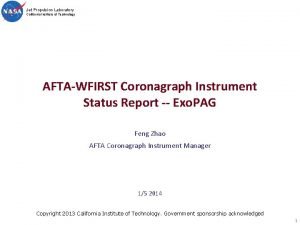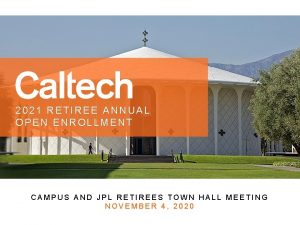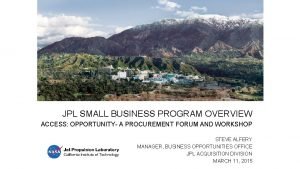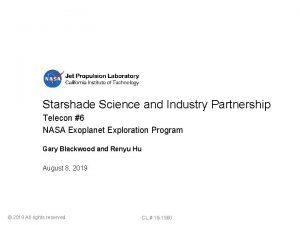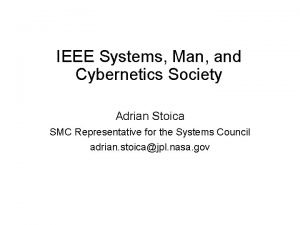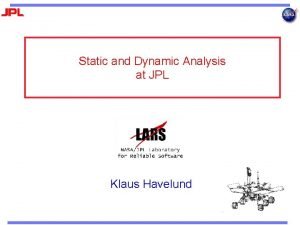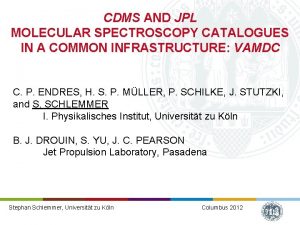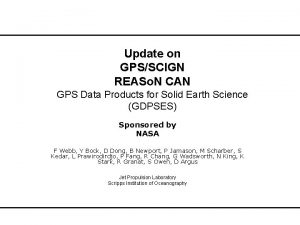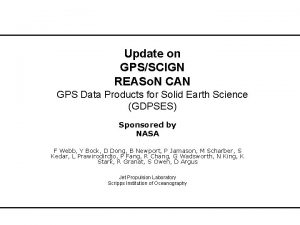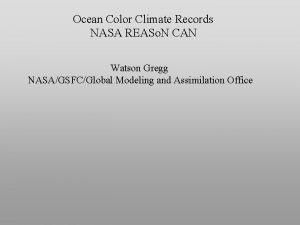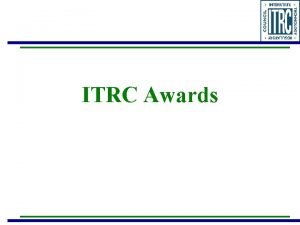JPL REASo N CAN Awards 1 2 3






- Slides: 6

JPL REASo. N CAN Awards 1. 2. 3. 4. 5. 6. Center for Real Time GPS Data and Environmental Products (Y. Bar-Sever) Sea Ice Motion and Deformation: Unique High-Resolution Products from RADARSAT Data at the Alaska SAR Facility (R. Kwok) Inter-Service Data Integration for Geodetic Operations – INDIGO (R. Neilan) GPS Data Products for Solid Earth Science Research and Applications (F. Webb) GENESIS-II: Data Fusion and Analysis for Multi-Sensor Earth System Science (T. Yunck) GRACE Products for Hydrology and Oceanography (V. Zlotnicki)

Inter-Service Data Integration for Geodetic Operations – INDIGO (R. Neilan) • Closely cooperating team between GSFC and JPL with aim to integrate data/systems of SLR, VLBI and GPS. Funding has been withheld or postponed by NASA HQ, due to difficulties facing the SLR network. Probably the biggest long term impact is that these critical data systems, GPS at JPL and GSFC, and the SLR and VLBI at GSFC are distanced (currently excluded) from the Strategy for the Evolution of ESE Data Systems (SEEDS) and SESWG Report emphasis on reference frames and access to science data. Need for additional funds to sustain and evolve these activities, especially the IGS Central Bureau at JPL. • • • – • Especially the GPS data information systems, which serves thousands of Earth science users on a daily basis. The Europeans are preparing a similar approach to integrated data systems now within IGGOS framework and this delay diminishes our leadership role in shaping integrated data information.

GENESIS-II: Data Fusion and Analysis for Multi. Sensor Earth System Science (T. Yunck) • We are developing an end-to-end workflow system to automatically gather, fuse, analyze, and archive results from multi-sensor Earth science data from multiple distributed data centers. – • • • Regard this as a model for future Earth science information systems and services. Partners: UCLA, USC, Univ. of Maine, Scripps, Caltech, JPL Divisions 32, 33, 36 Using AIRS, MODIS, MISR, GPS data; Goddard, Langley, and JPL DAACS; synergism with ongoing AIRS and MISR activities at JPL. Will deliver an early demo system in Dec 04. We are just now getting underway defining requirements and generating a level-3 schedule.

GPS Data Products for Solid Earth Science Research and Applications (F. Webb) • • Currently, SCIGN provides GPS data and metadata and only lowlevel data products. Builds on current capabilities within SCIGN for data archiving, information systems, and data analysis to disseminate: geodetic position time series, crustal motion models, strain rate maps, geologic fault models, near-real-time earthquake response information, geodetics reference systems for precise GIS and surveying, and aquifer recharge monitoring. Over the next five years, SCIGN will become an integral part of the multi-agency, multi-disciplinary Plate Boundary Observatory (PBO), an observatory of high-precision geodetic instruments spanning western North America. This project is intended to solidify NASA’s participation in PBO and the larger NSF-led Earth. Scope. Partners: SIO and USGS

Support of Program Planning and Analysis / Cross-Cutting Solutions (D. Tralli) • • • Working with University of Arizona (C. Hutchinson), and ICREST University of Missouri (V. Kaupp) in application of NASA risk management software tool to benchmarking of USDA/FAS PECAD/CADRE DSS Will be working with S. Ambrose on benchmarking of HAZUSMH Support of ISRSE and ISPRS activities

Applications Areas of Direct Interest • • Natural Hazards / Disaster Management and Homeland Security (with USGS, NSF, and DHS) Coastal Management (with NSF and NOAA) Air Quality (with NOAA, DOE, EPA) Carbon Management (with DOE)
